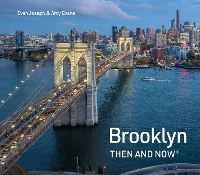|
|
regional (see also travel / pictorials)
|
|



|
|
| book details |
Brooklyn Then and Now (Then and Now)
By (author) Evan Joseph, By (author) Amy Evans

|
This book is currently unavailable. Enquire to check if we can source a used copy
|
| book description |
Pairing archive and contemporary photographs of the same location side-by-side, Brooklyn Then and Now® provides a visual chronicle of the borough’s past, full of rich history and culture. Home to more than 2.5 million people, this book is a testament to the New York City borough which has had many faces over the course of its fascinating history. Discover the streets and buildings that have witnessed generations of immigrants, industry workers and artists: those who today keep up the traditions which have characterized Brooklyn neighborhoods for decades and contribute to this vibrant cultural nexus. Featuring sites such as: the Brooklyn Bridge, Williamsburg, Bedford-Stuyvesant, Brooklyn Academy of Music, Brooklyn College, Coney Island, Brooklyn Paramount Theater, and more With incredible modern-day shots by award-winning photographer Evan Joseph Packed with carefully researched history full of intriguing figures, enlightening stories and public record Uncover the hidden history of this thriving, ever-changing borough in Brooklyn Then and Now.
| product details |
Normally shipped |
Publisher | HarperCollins Publishers
Published date | 5 Jun 2025
Language |
Format | Hardback
Pages | 144
Dimensions | 250 x 285 x 12mm (L x W x H)
Weight | 270g
ISBN | 978-0-0087-1610-3
Readership Age |
BISAC | photography / subjects & themes / regional (see also travel / pictorials)
| other options |
|
|
|
To view the items in your trolley please sign in.
| sign in |
|
|
|
| specials |
|
|
This first comprehensive biography of Cecil Rhodes in a generation illuminates Rhodes’s vision for the expansion of imperialism in southern Africa, connecting politics and industry to internal development, and examines how this fueled a lasting, white-dominated colonial society.
|
Let's stare the future down and, instead of fearing AI, become solutionists.
|
|
|
|
|